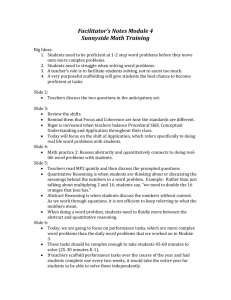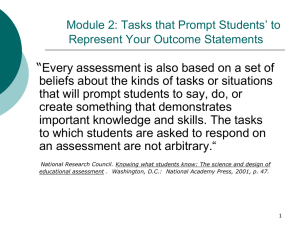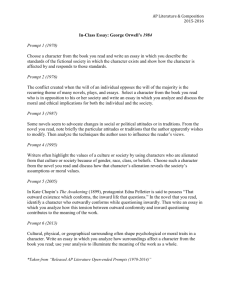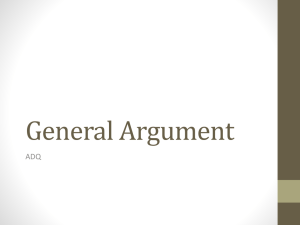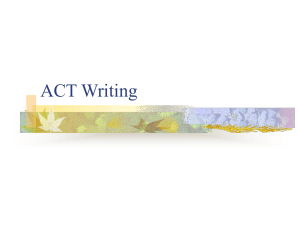Culture: Shaping Perception
advertisement
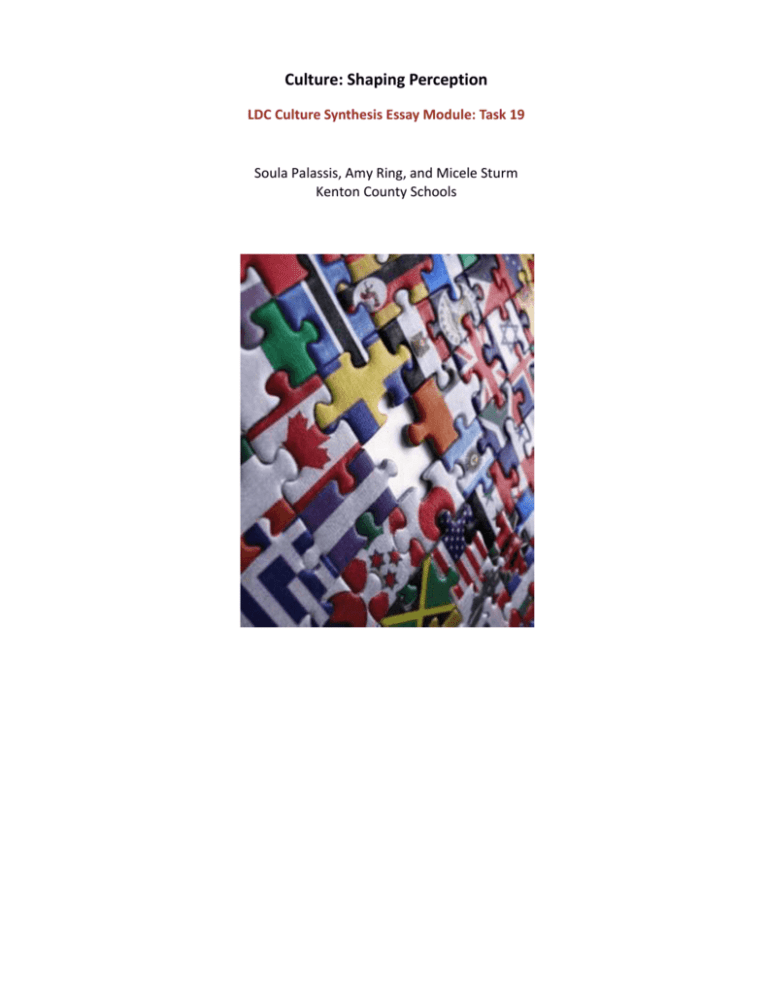
Culture: Shaping Perception LDC Culture Synthesis Essay Module: Task 19 Soula Palassis, Amy Ring, and Micele Sturm Kenton County Schools LDC Argumentative Module Module Title: Culture Synthesis Essay Module Description (overview): Students will write an essay that takes a position on the extent to which culture informs one’s perception. The essay will synthesize multiple sources and effectively defend the writer's position. Task Number, Type, and Level Task 19 Argumentative Level 2 (for general) Level 3 (for accelerated) Template Task Template Prompt [Insert question] After reading _________(literature or informational texts), write _______ (essay or substitute) that explains ______ (content). What conclusions or implications can you draw? Cite at least ______ (number) sources, pointing out key elements from each source. In your discussion, address the credibility and origin of sources in view of your research topic Identify any gaps or unanswered questions. Optional: Include _____(e.g bibliography) Completed Prompt To what extent does one’s culture inform the way one views others and sees the world? After reading selections of cultured texts, write a synthesis essay that explains to what extent does one’s culture inform the way one views others and sees the world. Cite at least three sources, pointing out key elements from each source. L2 In your discussion, address the credibility and origin of sources in view of your research topic. L3 for accelerated*** Grade(s)/Level: 10th Grade Discipline: English Course: English II Author: Soula Palassis, Amy Ring, and Micele Sturm Contact information: soula.palassis@kenton.kyschools.us, amy.ring@kenton.kyschools.us , and micele.sturm@kenton.kyschools.us Section 1: Standards Common Core Standards: Argumentation: The following College and Career Readiness (CCR) anchor standards apply to reading and writing in argumentative template tasks. Refer to the 6-12 standards for grade-appropriate specifics that fit each task and module being developed. The standards numbers and general content remain the same across all grades, but details vary. Number 1 3 8 9 10 Number 1 4 9 10 CCR Anchor Standards for Reading (Argumentation) Read closely to determine what the text says explicitly and to make logical inferences from it; cite specific textual evidence when writing or speaking to support conclusions drawn from the test. Analyze how and why individuals, events, and ideas develop and interact over the course of a text. Delineate and evaluate the argument and specific claims in a text, including the validity of the reasoning as well as the relevance and sufficiency of the evidence. Analyze how two or more texts address similar themes or topics in order to build knowledge or to compare the approaches the authors take. Read and comprehend complex literary and informational texts independently and proficiently. CCR Anchor Standards for Writing (Argumentation) Write arguments to support claims in an analysis of substantive topics or texts, using valid reasoning and relevant and sufficient evidence. Produce clear and coherent writing in which the development, organization, and style are appropriate to task, purpose, and audience. Draw evidence from literary or informational texts to support analysis, reflection, and research. Write routinely over extended time frames 9time for research, reflection, and revision) and shorter time frames (a single sitting or a day or two) for a range of tasks, purposes, and audience. Task Number/Type/Level Task 19 Explanatory Level 1 and Level 2 (for accelerated) Template Task Template Prompt [[Insert question] After reading _________(literature or informational texts), write _______ (essay or substitute) that explains ______ (content). What conclusions or implications can you draw? Cite at least ______ (number) sources, pointing out key elements from each source. L2 In your discussion, address the credibility and origin of sources in view of your research topic. L3 Identify any gaps or unanswered questions. Optional: Include _____(e.g bibliography) Teaching Task Background: Students began a unit on Cultural Conversations 2 weeks ago, and have since been exposed to pieces of cultural art, essays on family and cultural conflicts, memoirs, poetry, and film. All pieces have centered on the key theme of cultural identity. Prompt: How do external factors affect one’s sense of identity? After reading “Thanksgiving: a Personal History,” “An Indian Father’s Plea,” and other literary and informational texts, write a synthesis essay that analyzes how cultural identity influences an individual’s perspective. Support your position with evidence from at least three of the texts. Cite at least three sources, pointing out key elements from each source. Focus Reading/Research Controlling Idea Development Organization Conventions Focus Reading/Research Controlling Idea Development Organization Conventions Focus Reading/Research Controlling Idea Development Organization Conventions LDC Argumentation Rubric ADVANCED Addresses all aspects of the prompt with a highly focused and convincing response. Demonstrates accurate and effective use of reading materials to develop argument or proposal and a solid understanding of content as presented in the prompt. Establishes a substantive and credible claim or proposal Acknowledges relevant competing arguments, defending or qualifying the claim or proposal as appropriate. Develops a detailed and convincing argument or proposal; provides relevant evidence in the form of examples or explanations with statements from reading material. Makes a clarifying connection(s) that illuminates argument and adds depth to reasoning. Applies an appropriate text structure that develops reasoning; applies a logic model, such as deductive reasoning. Demonstrates a well-developed command of standard English conventions and cohesion; employs language and tone appropriate to audience and purpose. MEETS EXPECTATIONS Addresses the prompt and stays on task; provides a generally convincing response. Demonstrates generally effective use of reading materials to develop argument or proposal and an understanding of the content as presented in the prompt. Establishes a credible claim or proposal Acknowledges competing arguments while defending the claim or proposal. Develops a satisfactory argument or proposal using reasoning with adequate detail to support claim or proposal; provides evidence from text(s) in the form of examples or explanations relevant to the argument or proposal. Makes a relevant connection that helps to clarify argument or proposal. Applies an appropriate text structure that develops reasoning; applies a logic model. Demonstrates a satisfactory command of standard English conventions and cohesion; employs language and tone appropriate to audience and purpose. NOT YET Attempts to address prompt but lacks focus or is off-task. Demonstrates weak use of reading materials to develop argument or proposal. Establishes a claim or proposal but is weak or off task; Attempts to acknowledge competing arguments. Lacks details to support reasoning; examples or explanations are weak or not relevant. Connection is not relevant. Provides a weak text structure; composition is confusing. Demonstrates a weak command of standard English conventions; lacks cohesion; language and tone are not appropriate to audience and purpose. Overview: LDC Argumentative Instructional Ladder Classroom Pre-Instruction 1. Pre-test (optional) 2. Bridging conversation 3. Begin instructional sequence 4. Student project planning Reading Process 1. Essential Vocabulary 2. Note-taking 3. Active Reading Transition to Writing 1. Bridging conversation Writing Process 1. Initiation of task 2. Planning 3. Development 4. Revision/Editing 5. Final draft 6. Extensions Ability to read a text or multiple texts on a topic or issue and to write an informational product. Ability to establish knowledge base and assess skills and strategies necessary to manage task. Ability to understand and explain the teaching task’s prompt and rubric Ability to plan a task so that reading and writing processes are accomplished on time Ability to identify and master terms essential to understanding a text Ability to select important facts and passages for use in one’s own writing. Ability to identify the central point and main supporting elements of a text. L2 Ability to identify and analyze competing arguments L3 Ability to make clarifying connections and/or providing examples Ability to establish knowledge base and assess skills and strategies necessary to manage task. Ability to establish a controlling idea and consolidate information relevant to task. Ability to develop a line of thought and text structure appropriate to an Argumentative task. Ability to construct an initial draft with an emerging line of thought and structure. Ability to apply revision strategies to refine development of argument, including line of thought, language usage, and tone as appropriate to audience and purpose. Ability to apply editing strategies and presentation applications. Submit your final draft before or on due date for scoring and feedback. Ability to apply what is learned in the classroom to an experience involving non-school audiences and situations. Instructional Ladder Section 1 – Classroom Pre-Instruction 1. Pre-test (optional): None 2. Bridging Conversation: Ability to establish knowledge base and assess skills and strategies necessary to manage task. Prompt: In a quick write, write your first reaction to the task prompt. What strategies might you use to gain knowledge of the issue and form a claim or proposition? Product: Short constructed response Scoring guide: no scoring Instructional strategies: Teach or review content required for the task: history, literature, and non-fiction text depending on when in the sequence they teach the content – before or during the production of the task. Discuss the demands of making counter-arguments and providing examples from past/current events. 3. Begin instructional sequence: Ability to understand and explain the teaching task’s prompt and rubric. Prompt: In your own words, write a brief explanation of what the instructional task asks you to do. What knowledge and skills must you employ to complete this task? Product: Short constructed response Scoring guide: no scoring Instructional strategies: Review each student’s response to ensure she/he understands the task. Ensure relevant reading material is selected or provided. Have students share responses so that students can hear/know what each other is doing and encourage them to help each other when appropriate. Discuss in detail the prompt, type of writing and structure, the product, and the rubric. 4. Student project planning: Ability to plan a task so that reading and writing processes are accomplished on time Prompt: Create timeline for completing the instructional task within a given time frame. Product: Timeline Scoring guide: Timeline Meets Not yet Attempts to meet Creates a “doable” timeline that paces reading and writing the criteria for processes Proficient Instructional strategies: Model a common or sample timeline & homework Provide students with a timeline template Discuss the importance of planning Instructional Ladder Section 2 – Reading Process (Development of Skills and Cognition) 1. Essential Vocabulary: Ability to identify and master terms essential to understanding a text Passage: ”Thanksgiving: a Personal History” by Jennifer New Prompt: After reading “Thanksgiving: a Personal History” by Jennifer New, read through the essay one more time to highlight/mark/underline each mention of changing perspective. Speak with a peer about what you marked and why. Then, on your own, write one paragraph about how the author’s struggle with external forces changes her perspective of Thanksgiving. When you are finished with the paragraph, discuss the author’s tone with the class. Product: Constructed Response, Annotated Text After reading and annotating “Thanksgiving: a Personal History” complete (with a small group) a graphic organizer that shows the relationship between tone and transitional perspective. Product: Graphic Organizer Scoring guide: Meets Not yet Students accurately identify New’s changing tones and Attempts to meet perspectives and correctly cite lines from “Thanksgiving: a the criteria for Personal History” within their graphic organizer. Proficient Instructional strategies: Marking the Text, Small Group Discussion/Collaboration, Close Reading, Graphic Organizer 2. Note-taking: Ability to select important facts and passages for use in one’s own writing. Passage: “An Indian Father’s Plea” by Robert Lake Prompts: While reading “An Indian Father’s Plea” by Robert Lake, use metacognitive markers to identify the five key elements of an argument. Use a graphic organizer to compile your list. After marking the text, work with a partner to discuss the effectiveness of the writer’s organizational structure. Then, on your own, write a response to the following questions: Who is the author’s audience? How effective is the author in speaking to this audience? What is the author’s persona? How effectively does he come across to his audience? Products: Appropriately marked text/ Shared Constructed Response Scoring guide: Meets Not yet Text reflects a focus on the effectiveness of New’s arguments for Attempts to meet cultural understanding. It correctly cites lines from the essay for the criteria for support. Proficient Instructional strategies: Text marking toward author’s organizational structure, Think-Pair-Share strategies and Constructed Response structure and criteria for scoring. 3. Active Reading: Ability to identify the central point and main supporting elements of a text. Passage I: “Everyday Use” by Alice Walker Prompts: While reading “Everyday Use” by Alice Walker, underline evidence of the author’s changing perspective as it links to her past (specifically racism, sexism, and poverty). With a partner, create a Venn diagram that compares and contrasts the sisters’ characters with special focus on cultural components (family, education, occupation, and other subcultures). Then, on your own, write a response to the following Quick-Write question: How do cultural components impact each sister’s perspective of their mother, the quilt, and each other? Scoring guide: Meets Text insightfully compares the alternate perspectives of each component. It correctly cites lines from the memoir for support. Not yet Attempts to meet the criteria for Proficient Instructional strategies: Textual Marking, Think-Pair-Share, Quick-Write, Whole-Class Discussion, Venn Diagram Instructional Ladder Section 3 – Transition to Writing 1. Bridging Conversation: Ability to link reading results to writing task. Prompt: After our review discussion, write what you know about the prompt question: To what extent does a person’s culture inform the way he or she views others and the world? Product: Quick Write Paragraph or List of Concepts and Idea Scoring guide: No scoring Instructional strategies: small group discussion Instructional Ladder Section 4 – Writing Process (Development of Skills and Cognition) 1. Claim: Ability to establish a claim and consolidate information relevant to a task. Prompt: Review the texts you have read (in Units 1 and 2, as well as outside texts) and your personal experiences with culture. Determine how you could use several of those texts to defend, challenge, or qualify the prompt question. Product: Quickwrite Scoring guide: Proficient Not yet Text accurately chooses texts and personal experiences to defend, Attempts to meet challenge, or qualify their answer to the prompt question. the criteria for Proficient Instructional strategies: Quickwrite 2. Planning: Ability to develop a line of though and text structure appropriate to an argumentation task. Prompt: Reread the texts you’ve chosen and complete a graphic organizer that outlines your synthesis paper. Organizer will consist of your position, an author whose work is relevant to your conversation, a description of how the author’s work is relevant, and 3 specific examples of how the author supports/refute your claim. Product: Graphic Organizer Scoring Guide: Proficient Scoring Guide is accurately and relevant completed. Support evidence is strong. Not yet Attempts to meet the criteria for Proficient 3. Development: Ability to construct an initial draft with an emerging line of thought and structure. Prompt 1: Write a thesis statement for your composition with one or two sentences that establish the controlling idea and provides a hook for your reader. Product: Opening paragraph Scoring guide: Opening/Lead Paragraph(s) Proficient Not yet Attempts to meet Provides an opening to include a controlling idea (claim) and an the criteria for opening strategy relevant to the prompt (2-3 point thesis) Proficient Writes in readable prose Prompt 2: Write an initial draft to include multiple paragraphs: an opening paragraph (with hook and claim), a body paragraph with examples of the influence of family on perspective, a second body paragraph with examples of the influence of ethnicity on perspective, a third body paragraph with concessions and refutations and a conclusion with a summary and a call to action. Scoring guide: Rough Draft Proficient Provides an opening to include a controlling idea (claim) and an opening strategy relevant to the prompt (2-3 point thesis) Develops a detailed and convincing argument for claim, provides relevant evidence in the form of examples or explanations with statements from reading material support/citation. Writes in readable prose Not yet Attempts to meet the criteria for Proficient Instructional strategies: How to open a composition – e.g, with background information, a question, quote, or grand sweeping statement The “ingredients” of an opening paragraph, such as author’s name, etc. How to end a composition –e.g. as a comment about next steps, a restatement of main finding or a description of unanswered questions Use of template for all levels to guide students through first draft 4. Revision: Ability to refine text, including line of thought, language usage, and tone as appropriate to audience and purpose. 5. Editing: Ability to proofread and format a piece to make it more effective. Prompt: Apply revision strategies for clarity, logic, language, cohesion (students should do at least 2 drafts). Finalize draft for the readership; apply finishing touches (e.g. visuals, neatness, formatting, copy editing). Product: Revised draft Scoring guide: Draft Proficient Demonstrates use of revision strategies that clarify logic and development of ideas; embeds relevant details; improves wordusage and phrasing; and creates smooth transitions between sentences and paragraphs Applies a text structure to organize reading material content and to explain key points related to the prompt Demonstrates use of strategies that enhance the readability and appearance of the work for presentation Not yet Attempts to meet the criteria for Proficient Instructional strategies: Develop ways to manage revision process so that students get feedback in timely and helpful ways Draft study (students volunteer a segment for class or small group help and discussion) Peer feedback on clarity of thinking and development of claim/argument Read-aloud for peer and adult feedback Strategies for embedding informational – citation methods, quoting, paraphrasing Use of error analysis to encourage self-correction of language usage and grammatical error 6. Completion: Ability to submit final piece that meets expectations. Prompt: To what extent does one’s culture inform the way one views others and sees the world? After reading selections of cultured texts, write a synthesis essay that explains to what extent one’s culture informs the way one views others and the world. Cite at least three sources, pointing out key elements from each source. L2 In your discussion, address the credibility and origin of sources in view of your research topic. L3 for accelerated*** Product: Argumentative Essay Synthesizing Culture’s Impact on Perspective Scoring: Argumentative Rubric (above) Professional development: Scoring Calibration

